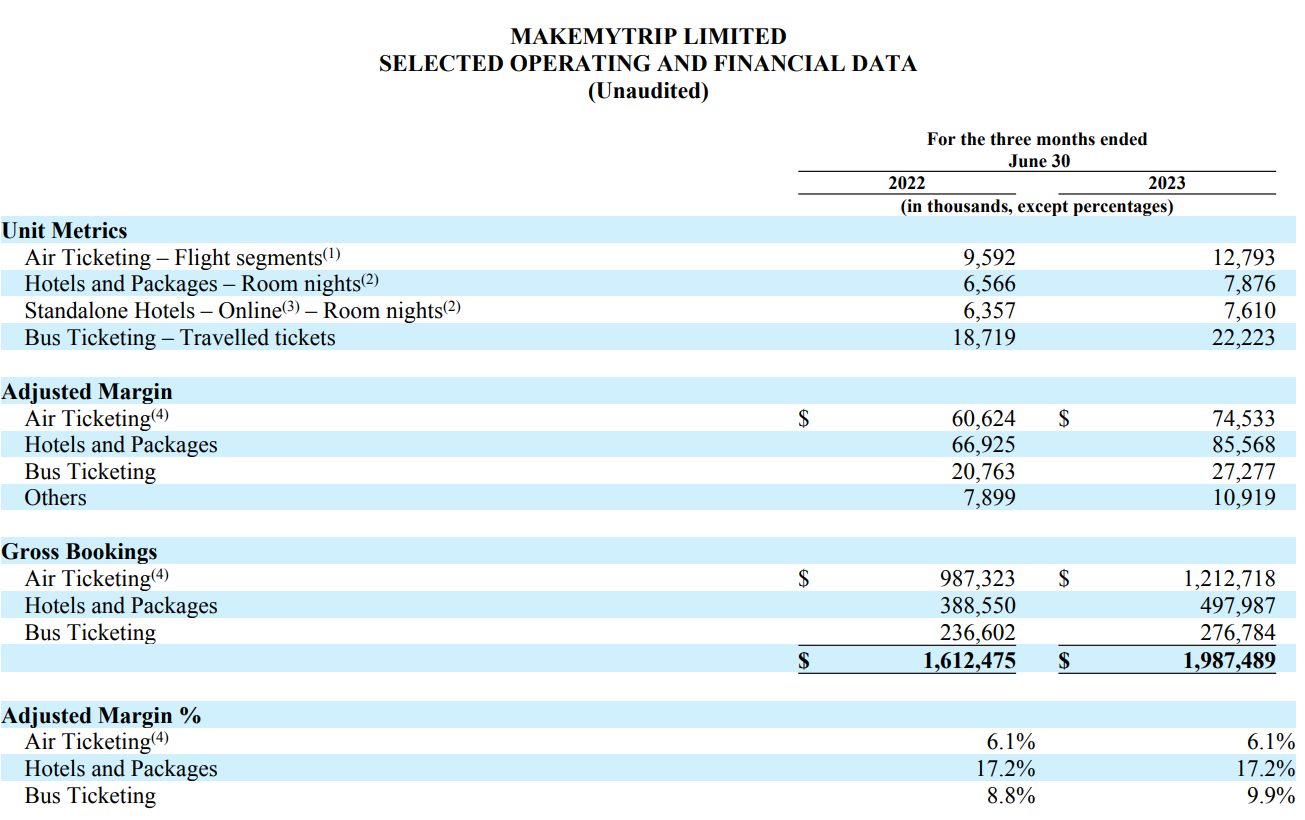

登錄


登錄
海擇短評 Haize Comment:
印度OTA MakeMyTrip(NASDAQ: MMYT)近期公告2023Q2財報,本季公司在各細分市場的產量都超過了疫情前(2019年),總交易額與稅後淨利也創下歷史新高;雖然做為當地最大巨頭,MakeMyTrip在印度的完全復甦比Booking、Airbnb在歐美的復甦晚了整整一年,但考慮印度在2021年的重大疫情,能在兩年間完全復甦已是難能可貴。海擇資本解讀MakeMyTrip本季財報如下:
1. GAPP淨利再創新高:MakeMyTrip本季總交易額(19.9億美元)、收入(1.97億美元)、淨利(1,915萬美元)都創下歷史新高,淨利已經連續6個季度增長,並首次突破千萬美金量級,與2019年同期虧損4259萬美元相比,已有明確翻轉,堪稱浴火鳳凰。
2. 住宿產業競爭再起:從各細分市場看,MakeMyTrip的產量都超過疫情前,且各事業部單獨結算都有盈利能力。相較2019年同期,本季機票銷售1,279萬航段、增長4%,交易額12.12億美元、增長23%;住宿銷售1,549萬間夜、增長4%,交易額4.98億美元、增長9%;地面交通(公共汽車票、城際計程車、火車票)銷售2,222萬張票、增長6%,交易額2.77億美元、增長9%。不過住宿的間夜平均佣金率從2019年的22.3%掉到本季的17.2%,表示復甦的同時,競爭也趨於激烈;地面交通佣金率則從8.4%成長到9.9%,我們認為是源於產品結構調整。
3. 提前布局非一線城市:疫情以來,從電話會議可以得知MakeMyTrip已進入了印度二線、三線城市的布局,比如以出發前24-48小時才需要付款的零支付(zero payment),兼顧現付的靈活與預付的庫存保障。從人均GDP看,印度2022年為2,301美元,在亞洲大概是越南(4,110美元)與印尼(4,783美元)的一半,從這個角度看,只耕耘一線城市足矣;但龐大的人口基數也意味著,從絕對值看,印度仍然有龐大的中產消費者,與其質疑MakeMyTrip投入非一線城市的時間點,倒不如說,怎麼找到這些城市中有能力的消費者更為重要。東南亞國家在互聯網時代形同跳過桌上型電腦,直接進入手機移動上網;在金融上也跳過了信用卡,直接進入電子支付;印度的旅遊公司(也許不一定是MakeMyTrip)有沒有能力在印度找到或形塑類似的新趨勢,會是值得觀察的點。
4. 市值的合理性:從本益比看,我們如果預估MakeMyTrip一年能有1億美金的盈利能力,對應現在接近40億美元的市值,它是遠遠比市場頂級的Booking(NASDAQ: BKNG)、Airbnb(NASDAQ: ABNB)貴太多了。但如果從亞洲看,即便只看(消費較高的)出境旅遊人次,印度的復甦速度也遠遠快過其他國家;2019年印度出境旅客人次為2,692萬,在亞洲僅排名第五,落後於中國、南韓、日本和台灣;但即便是疫情未徹底淡逝的2022年,根據印度旅遊部(Ministry of Tourism)的統計,當年出境旅客人次已達2,110萬,僅次於中國的2,315萬,如果中國扣除548萬的內地赴港澳人次,印度就以龐大的增速處於亞洲第一,市值是否合理,就看各機構對印度2024年後的增長怎麼估算了。
----------
The Indian OTA MakeMyTrip (NASDAQ: MMYT) announced its Q2 2023 financial results. This quarter, the company's volume in various travel sectors exceeded that of the pre-pandemic period (2019), and both GMV and post-tax net profit reached historical highs. Although as the local giant, MakeMyTrip's full recovery lagged a full year behind that of Booking and Airbnb, considering the 2021 major outbreak in India, it's commendable that they fully recovered within two years.
1. GAAP net profit hits a new record: MakeMyTrip's total GMV ($1.99 billion), revenue ($197 million), and net profit ($19.15 million) this quarter all set historical highs. The net profit has grown for six consecutive quarters and has surpassed the ten-million-dollar mark for the first time. Compared to a loss of $42.59 million in the same period in 2019, there has been a clear turnaround.
2. Competition emerged again in the accommodation sector: MakeMyTrip's volume exceeded pre-pandemic levels at various travel sectors, and each sector is individually profitable. Compared to the same period in 2019, this quarter's flight sales reached 12.79 million segments, an increase of 4%, with a GMV of $1.212 billion, up 23%. Accommodation sales hit 15.49 million room-nights, up 4%, with a GMV of $498 million, an increase of 9%. Ground transportation (bus, taxi, train) sold 22.22 million tickets, an increase of 6%, with a GMV of $277 million, up 9%. However, the accommodation average commission dropped from 22.3% in 2019 to 17.2% this quarter, indicating that while there's recovery, competition has intensified. The commission rate for ground transportation grew from 8.4% to 9.9%, which we believe is due to adjustments in product structure.
3. Early Deployment in Non-First-Tier Cities: From the conference call, we learned that MakeMyTrip has begun its expansion into India's second and third-tier cities. For instance, they have introduced "zero payment" which allows payments 24-48 hours before departure, striking a balance between the flexibility of pay-on-arrival and the inventory security of pre-payment. India's GDP per capita stood at $2,301 in 2022, roughly half that of Vietnam ($4,110) and Indonesia($4,783). From this perspective, focusing solely on first-tier cities would suffice. However, the vast population also means that, in absolute terms, India still has a large middle-class consumer base. Instead of questioning the timing of MakeMyTrip's expansion into non-first-tier cities, it's more important to consider how they can identify and cater to capable consumers in these cities. Southeast Asian nations, in the internet age, essentially skipped desktop computing to mobile internet. Similarly, they leaped over credit cards directly into digital payments. Whether travel companies in India (not necessarily MakeMyTrip) have the ability to identify or shape similar trends in India is a point worth observing.
4. Market Cap: In terms of price-to-earnings ratio, if MakeMyTrip could achieve a profit of $100 million in a year, with its current market cap nearing $4 billion, it's much pricier than market giants like Booking (NASDAQ: BKNG) and Airbnb (NASDAQ: ABNB). However, looking from an Asian perspective, even if we focus solely on outbound travel tourists (higher spending), India's recovery rate surpasses many other countries. In 2019, outbound travelers from India numbered 26.92 million, ranking fifth in Asia, behind China, South Korea, Japan, and Taiwan. Yet, even in 2022, when the pandemic hadn't completely subsided, according to statistics from the Indian Ministry of Tourism, the country's outbound travelers reached 21.10 million, just behind China's 23.15 million. If we subtract the 5.48 million travelers from mainland China to Hong Kong and Macau, India, with its massive outbound travel growth, takes the lead in Asia. Whether the market cap is reasonable or not hinges on how institutions forecast India's growth post-2024.
----------
인도 온라인 여행사 메이크마이트립(MakeMyTrip, NASDAQ: MMYT)은 2023년 2분기 재무실적을 발표했다. 이번 분기에 회사의 각 관광분야에서의 업무량은 코로나19 발생전(2019년)을 초과했으며 총 GMV와 세후순이익은 모두 사상 최고 수준에 달했다. 로컬 대기업인 메이크마이트립의 실적 회복은 부킹이나 에어비앤비보다 꼬박 1년 늦었지만, 2021년 인도의 코로나19 유행을 고려하면 2년 안에 완전히 회복할 수 있다는 점도 칭찬할 만하다. 다음은 하이저 캐피털의 이번 실적에 대한 분석이다.
1. GAPP 순이익이 신기록을 기록했다. 메이크마이트립은 이번 분기 전체 GMV(19억9,000만 달러)와 영업수익(1억9,700만 달러), 순이익(1,915만 달러) 모두 사상 최고치를 기록했다. 순이익은 6분기 연속 증가하며 처음으로 천만 달러를 돌파했다. 2019년 같은 기간 4,259만 달러의 적자를 낸 것과 비교하면 이미 눈에 띄게 호전됐다.
2. 숙박업이 다시 경쟁 양상을 보이고 있다. 메이크마이트립은 각 여행업에서 코로나 이전 수준을 웃도는 실적을 올리며 사업별로 흑자를 내고 있다. 2019년 같은 기간과 비교했을 때 이번 분기 항공권 매출은 1,279만 항단으로 4% 증가했다. GMV는 23% 증가한 12억1,200만 달러였다. 숙박은 4% 증가한 1,549만 room nights를 판매했다. GMV는 9% 증가한 4억9,800만 달러였다. 지상 교통(버스, 택시, 기차)은 6% 증가한 2,222만장이 팔렸다. GMV는 9% 증가한 2억7,700만달러였다. 그러나 숙박 평균 커미션은 2019년 22.3% 에서 이번 분기 17.2%로 떨어졌다. 이는 회복에도 불구하고 경쟁이 심화되고 있음을 보여준다. 지상 교통의 커미션율은 8.4%에서 9.9%로 증가했다. 우리는 이것이 제품 구조의 조정 때문이라고 생각한다.
3. 비일선 도시에 미리 배치한다. 전화 회의에서 우리는 메이크마이트립이 인도의 2, 3선 도시로 확장되기 시작했다는 것을 알게 되었다. 예를 들어, 항공기가 출발하기 24~48시간 전에 지불할 수 있는 'zero payment'를 도입하여 현재 지불의 유연성과 선불의 재고 보장 사이에서 균형을 이루었다. 2022년 인도의 1인당 GDP는 2,301달러로 베트남(4,110달러)과 인도네시아(4,783달러)의 절반 정도다. 이런 관점에서 보면 1선 도시에만 관심을 기울이면 충분하다. 그러나 방대한 인구기수는 절대치로 볼 때 인도가 여전히 방대한 중산층소비군체를 갖고 있음을 의미한다. 메이크마이트립의 비일선 도시 진출 시기에 의문을 제기하기보다는 이들 도시 중 유능한 소비자를 어떻게 찾느냐에 초점을 맞추는 것이 낫다. 인터넷 시대에 동남아 국가들은 데스크톱 컴퓨터 사용을 건너뛰고 휴대전화 모바일 인터넷으로 직행했다. 금융 결제에서 그들은 신용카드를 건너뛰고 디지털 결제로 직행한다. 인도의 관광 회사(메이크마이트립이 반드시 아님)가 인도의 유사한 추세를 찾거나 형성할 수 있는 능력이 있는지 살펴볼 필요가 있다.
4. 시가의 합리성: 수익률로 볼 때 메이크마이트립의 현재 시가는 40억달러에 접근한다. 만약 그것이 1년 내에 1억 달러의 이익을 실현할 수 있다면, 그것의 평가액은 Booking(NASDAQ: BKNG)과 Airbnb(NASDAQ: ABNB) 등 시장 대기업보다 훨씬 높을 것이다. 아시아 지역에서 우리가 (소비 능력이 더 높은) 내국인 출국자 수에만 관심을 갖더라도 인도의 관광업 회복 속도는 많은 다른 나라들을 능가한다. 2019년 인도의 내국인 출국자 수은 2,692만명으로 아시아 5위로 중국, 한국, 일본, 대만에 뒤졌다. 그러나 인도 관광부(Ministry of Tourism, Government of India)의 통계에 따르면 코로나19가 완전히 끝지 않은 2022년에도 인도의 내국인 출국자 수는 2,110만 명으로 중국의 2,315만 명에 이어 두 번째로 많다. 인도는 중국에서 홍콩과 마카오까지 548만 명의 내국인 출국자 수을 빼면 엄청난 해외여행 증가 속도로 아시아 1위를 달리고 있다. 시가총액이 합리적인지는 각 기관이 2024년 이후 인도의 성장 상황을 어떻게 예측하느냐에 달려 있다.

文章鏈接 Hyperlink:https://investors.makemytrip.com/investors/press-releases/default.aspx
資料來源 Resource:Makemytrip
標籤 Label:India OTA MMYT ABNB BKNG Post-pandemic